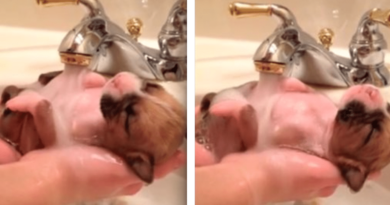How To Stop Your Dog from Excessive, Nuisance Barking
This post may contain affiliate links. We may earn money or products from the companies mentioned in this post.
You love your dog. But he barks. And barks. And barks…
He keeps your neighbors awake. And they’re complaining about the noise.
You may even be fined because of the barking.
What can you do?

Of course, dogs bark. Barking is a natural way dogs communicate.
But we have to teach them that constant barking isn’t allowed. We have to stop the nuisance barking.
In order to fix the noise problem, it’s important to first figure out why your dog’s barking.
Then, there are different methods you can try to teach him to stop barking so often.
Why Dogs Bark
Barking is a way dogs communicate. But they bark for a number of reasons ranging from boredom to excitement.
Once you determine why your pup’s barking, it will be easier to teach him not to bark so often.
And each dog is an individual. He may bark for various reasons depending on the circumstances.
Boredom or Loneliness Barking
Dogs are pack animals. They want company.
A dog who’s left alone too long or too often may bark because he’s lonely and unhappy.
Territorial or Protective Barking
Some dogs bark to ward off newcomers and protect their territory.
They will generally bark louder and faster the closer the perceived threat comes.
They may see and/or hear the threat.
When a dog barks in this manner, he appears to be very alert and aggressive.
Alarm Barking Out of Fear
When a dog barks because a sight or sound startles him, he appears to be fearful. His tail may be tucked and his ears held back.
Barking Greeting or in Play or Excitement
When dogs are playing or greeting a person or another dog, they sometimes bark or yip.
Such a happy bark is often accompanied by a wagging tail, spinning, or jumping.
Attention-Seeking Barking
Some dogs bark when they want something.
They may be telling you that they want to go outside, to play, or to get a treat.
My Aussie Mix puppy Millie barks for attention and because she wants to play ball. But I’m working with her and she’s getting much better.
Separation Anxiety Barking
Dogs with separation anxiety may bark because they’re stressed.
They may also pace, be destructive, have inappropriate elimination, and other similar behaviors.
Compulsive Barkers
A dog who compulsively barks may do so to hear his own voice.
Such a compulsive barker may also exhibit other stereotypic behaviors such as running in circles or back-and-forth along a fence.
He may also have other compulsions, such as chasing light, shadows, and reflections in mirrors.
Barking Because of Illness or Injury
Some dogs bark because they have a painful condition or don’t feel well.
Frustration-Induced Barking
Some dogs bark when they can’t reach a playmate or a person or anything else they want.
This happens when dogs are somehow confined, such as on leash, by a tether, or in a yard.
Barking By Aging Dogs
Some dogs bark more as they age. They may even bark for hours on end, unaware that they’re doing so.
This may be caused by canine cognitive dysfunction, vision impairment, deafness, or other ailments
Barking To Tell You He Needs Something
A dog may bark when he’s hungry, thirsty, or too hot or cold.
How To Prevent Nuisance Barking
The easiest way to deal with a problem behavior is to prevent it before it becomes a habit.
1. Exercise and Play With Your Dog
A well-exercised dog is less likely to have problem behaviors, including barking. So make sure that your pup receives an appropriate amount depending on his breed, age, and health.
2. Meet Your Dog’s Needs
Make sure that your dog’s basic needs are met. He should receive enough food at his meals and have access to fresh water.
Also, he shouldn’t be left in an environment that’s too hot or too cold.
3. Maintain a Consistent Daily Schedule
Dogs are creatures of habit. They thrive in an environment where they know what to expect.
So it’s important that your dog eat, play, exercise, be socialized, and be trained on a regular schedule.
4. Provide Mental Stimulation
In addition to training, it’s important for your dog to receive mental stimulation through devices like treat-dispensing toys and puzzle toys.
5. Block Noise and Visual Stimulation
Instead of waiting to correct a barking problem, you can block noise by playing a white noise machine or the TV or radio so that outside noises are muffled.
Or you can block your pup from looking out a window where he might see things that would stimulate him to bark, such as a squirrel outside the window or a person going by on a bike.
How To Treat Excessive Barking
When you got your dog, you probably expected some barking. Just not hours on end.
But, in order to stop the nuisance barking, it’s important to figure out why he’s barking. Then, you can try various techniques to lessen and control his barking.
Of course, it will take time and patience to deal with this problem. And it may require you to use more than one technique to be successful.
1. Exercise
Dogs who have too much energy often bark excessively. They need an outlet.
They need to let off steam–doggy style.
This is especially true if you have a high-energy breed or a young dog.
A walk or fetching a toy can help.
Mental exercise by doing obedience training can also help take the edge off your pup’s excessive energy.
How much exercise your dog needs depends on your individual pup.
For my rescued Aussie mix Millie, a walk is just a warm-up. She needs a good ball-playing session to help her be able to settle down.
Whereas a short walk is plenty for my Lhasa apso Ralphie.
If I didn’t give Millie enough exercise, she would be much more likely to bark excessively.
2. Socialization
The better a dog is socialized to new experiences, sights, and sounds, the less likely he is to be reactive towards them and bark.
So try to take your dog to new places and to meet new people. Get him used to seeing bikes, joggers, and cars passing by.
Go to shopping centers where he’s allowed and practice some commands he knows.
Praise and reward him for calm behavior.
3. Manage Your Dog’s Surroundings
If your dog’s barking out the window at everything he sees such as the squirrel, the delivery person, and the jogger passing by, block the view.
Either close the drapes or the shade. Or have the dog stay in another room so that he can’t see the tempting sights.
For dogs who bark at sounds, such as another dog barking or the squeals of children playing outside, block the sound.
As long as the temperature permits, close the window. Or play white noise, a TV, or a radio to block the sound.
4. Ignore the Barking
Ignoring doesn’t work to stop all types of barking. But not responding to your dog’s barking can help stop it if he’s barking for attention or for something he wants, like a treat or to play.
But you have to be consistent. If you tell him to “stop it” sometimes and other times ignore him, he probably will keep barking because it works for him: it gets him attention.
Never reward the barking. Even giving some dogs eye contact when they bark can be seen as a reward.
The key to ignoring the barking is to immediately reward when he’s quiet. So have your small treat ready and praise him for being quiet.
His reward can even be something that will keep him occupied, such as a stuffed Kong,
I use the Kong Extreme and stuff it about half full with a high-quality pate dog food, then freeze it overnight.
5. Teach a Quiet Cue
You can teach your dog to speak and be quiet on cue.
I did this with my dogs. Three of my breeds tend to be barkers. So it was important that they learned that being quiet is what was desired.
When your dog barks, you can say “speak.” Then, the split second that he stops barking, tell him “quiet.”
Praise and reward him for being quiet. Expect him to be quiet for longer and longer periods before rewarding him.
6. Teach a Settle Cue
Teaching a dog to be calm and lie down on cue has many uses.
It can be used when you have company or when you’re working at your computer. And when you need a dog to be quiet.
7. Teach an Incompatible Behavior
You can teach your dog to perform a command instead of barking when something occurs that would normally stimulate him to bark.
So, for example, if your dog barks when the doorbell rings, you can teach him to sit and stay instead when it rings.
Or you can teach your dog to bring you a toy instead of barking at you for attention.
8. Provide Activity Toys
There are so many devices that can keep your pup entertained. You can stuff a Kong.
It takes some time for my dog to work on it. It also redirects his attention to the Kong instead of surrounding sights and noises.
I also like leaving puzzle toys. Activity devices keep your dog busy.
They can distribute kibble or treats by rolling them or opening compartments.
Mental exercise also helps tire a dog out and helps him to de-stress.
9. Get Appropriate Professional Assistance
If you’ve tried to stop the barking unsuccessfully on your own, it’s advisable to get the help of a professional behavior specialist.
This is especially true if your dog is a compulsive barker. If, even after you’ve increased his exercise, mental stimulation, and the manner of confinement, he still barks, it’s time to get help.
The longer the nuisance barking continues, the harder the problem will be to fix.
It’s also important to get professional help if your dog has anxious behavior such as separation anxiety.
10. Use Anti-Stress Devices
There are many devices that can help lower a stressed dog’s anxiety level.
These include devices that emit stress-releasing pheromones and anxiety wraps and jackets.
11. Desensitize Your Dog
You can get your dog used to sounds that he otherwise would bark at.
At first, you can play a sound like a doorbell or dog barking at a low level. Praise and reward your pup for not barking.
Over time during your training, increase the volume, still praising and rewarding your pup for being quiet.
You can do the same type of training exercise to sights at which he barks. First do so at a distance at which he doesn’t bark. Praise and reward calm, quiet behavior.
As he progresses over training sessions, get closer to the stimulus. Praise and reward desired behavior.
Remember to only progress as fast as your dog can handle the training.
12. Don’t Leave Your Dog Unattended
If your dog barks at anything that moves or at noises when left in the yard, don’t leave him in the yard alone.
You should also teach your dog a reliable recall so that you can always call him away from something he wants to bark at.
13. Ensure That Your Dog’s Needs Are Met
Make sure that your dog’s food and water needs are met so that he doesn’t have to bark because of hunger or thirst.
Also, make sure that his environment isn’t too hot or cold.
What NOT To Do: Don’t Try This at Home
There are many ways to train a dog. But many are aversive and shouldn’t be used.
Punishment should not be used in dog training or behavior modification.
Don’t Use Anti-Bark Collars
Although some dogs may stop barking if shock or spray collars are used, there are better methods that can achieve the desired result.
Also, using them may lead to temporary results and may even make barking worse or lead to other undesired behaviors.
Don’t Close the Dog’s Muzzle
Believe it or not, some people have even tried to stop a dog from barking by tying his muzzle closed with rubber bands, rope, or cord.
Of course, doing this is not only dangerous and painful, but it’s also inhumane.
Even using a muzzle can be dangerous if the dog can’t breathe or drink water normally. And it doesn’t teach what behavior is desired.
Don’t Use Aversive Sound Devices
There are shake cans and compressed air devices that make noises to stop a dog from barking.
Generally, these devices might briefly interrupt a dog from barking. But usually the dog will continue barking after the sound stops.
And if the dog is reactive to sounds, it may even cause him to bark more. If the pup is afraid of sounds, their use will escalate his fear.
Don’t Inadvertently Encourage Barking
Sometimes we create a barking issue without meaning to.
You might ask your dog “who’s coming?” when the doorbell rings or there’s a knock at the door.
The dog may already be stimulated by the sound at the door. By adding to his excitement, you may even make him unable to contain his frenzy.
Don’t De-Bark
There are so many other, better ways to help your dog not engage in nuisance barking than by having a veterinarian de-bark him.
Also, dogs who’ve been de-barked still make sound. It’s just more muffled.
Final Thoughts
We expect our dogs to bark. But we have to make sure that they don’t engage in nuisance barking.
We can do things, such as exercise our dogs mentally or physically, to help prevent him from barking excessively.
It’s important to discover why your dog’s barking to be able to fix it. Then, there are numerous techniques to deal with it.
Does your dog bark excessively?
What have you done to deal with it?
Please tell us in the comment section below.
Save To Pinterest

Top Picks For Our Puppies
- BEST PUPPY TOY
We Like: Snuggle Puppy w/ Heart Beat & Heat Pack – Perfect for new puppies. We get all of our Service Dog pups a Snuggle Puppy. - BEST DOG CHEW
We Like: Best Bully Sticks – All of our puppies love to bite, nip, and chew. We love using Bully Sticks to help divert these unwanted behaviors. - BEST DOG TREATS
We Like: Wellness Soft Puppy Bites – One of our favorite treats for training our service dog puppies. - BEST FRESH DOG FOOD
We Like: The Farmer’s Dog – A couple months ago we started feeding Raven fresh dog food and she loves it! Get 50% off your first order of The Farmer’s Dog.
Check out more of our favorites on our New Puppy Checklist.




